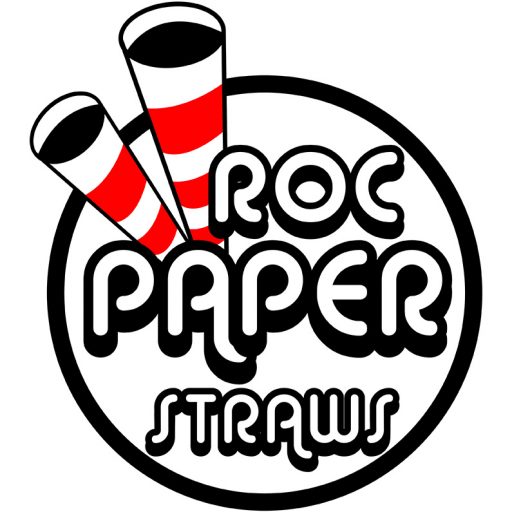The following article was originally featured in South Wedge Quarterly written by Katie Libby. Click here to read the original post.
Karrie Laughton wasn’t looking to open another business. As the owner of the busy Lux Lounge on South Avenue, she had enough on her plate. But when she decided to make the transition from plastic to paper straws at Lux, supply and demand seemed to make the decision for her. At the time that she started to purchase paper straws, there was only one company in the United States that was making them. As the paper straw trend caught on, she found herself waiting for sometimes three months for the company to fulfill the order. She checked around with local restaurant distributors and found that they were experiencing the same issue. After checking with one distributor for the third time she jokingly said to him, “Well maybe I should start making my own paper straws.” He replied, “Young lady, if you do that you’ll be a very rich woman.” Meanwhile, in Colorado, Karrie’s mom, Kathryn Laughton was enjoying her retirement and definitely not expecting the phone call from Karrie ask- ing if she would like to move back to Rochester and open a paper straw factory. “You don’t need to retire, let’s open a business,” Karrie said. Kathryn agreed and after the first of the year Roc Paper Straws will open at 920 Exchange Street.
Karrie and Kathryn have spent the last year doing research, finding the space and the equipment, building out the space, and are nearly ready for production and distribution. The location houses other small businesses like Community Composting and Small World Food.
Roc Paper Straws will initially distribute basic paper straws that will be available in various colors and patterns and will be available sleeved or non-sleeved. The plan is to eventually distribute a bendable straw but want to walk before they run. They want to use recycled paper whenever possible and are also exploring bamboo and hemp as alternate materials to produce the straws. “In everything we’re trying to do, we want to keep the footprint as small as possible,” says Karrie. Roc Paper Straws will target bars and restaurants initially as potential customers, due to Karrie’s extensive experience with the former. The cost of a paper straw is significantly more than a plastic straw, but there are two things that businesses need to consider when making the decision, according to Karrie. One, if the environment important enough to you to make this change and two, figure out a way to counteract the cost. For Lux, that meant not providing straws with each drink, but instead having dispensers placed at various points along the bar so patrons can grab their own if they want. She estimates the amount of straw usage at Lux has decreased by at least half. That enables her to counteract the cost because she does not have to buy as many as she would if she were continuing to use plastic straws and putting them in every customer’s drink. Making the switch as daunting at first for her staff and customers. “Everyone was freaking out,” she says, “staff had to get used to not putting straws in every drink and our customers were confused at first, but within a couple weeks it turned into a really positive routine.” With every new trend, there have to be naysayers that come out of the woodwork and that has been true for the paper straw boom. Many complain about the quality of the paper straw and how long it will last in your drink. To this, Karrie and Kathryn say to be gentle. “People are rough on plastic straws, you can chew on them, bend them, you just have to be gentler with a paper straw. If you use them the way you’re supposed to use a straw, there’s no problem.”
In addition to offering online ordering through their website, rocpaperstraws.com, the business will also have a small retail space at the Exchange Street location that will offer small packages of straws. If bars or restaurants run out, they can come to the store and pick up a couple packages while they wait for a larger order. Both Karrie and Kathryn have decreased their consumption of plastic products since they began their research into starting this business. “Each little thing does add up and make a difference,” says Karrie, “if you consciously try to use as minimal single use plastics – if each person would be aware of their amount of use – it would make a huge difference.” If you’re interested in learning more about or ordering from Roc Paper Straws, email rocpaperstraws@gmail.com.
Suck it up! Switch to Paper
Plastic never goes away. An estimated 380 million tons of non-biodegradable plastic is produced worldwide per year. Larger chunks of plastic eventually break down into micro-plastic (less than 5mm) that get stored in the fatty tissues of the foods we eat and ends up in the water we drink.
Over 260 species have been reported to ingest or become entangled in plastic debris, which has resulted in impaired movement, restricted feeding, reduced reproduction, lacerations, ulcers, and often death.
Approximately 9.1 billion tons of plastic have been produced since being introduced in the 1950’s. This is roughly the same as the entire weight of humanity.
Virtually every piece of plastic that has ever been made still exists in some shape or form, with the exception of the small amount that has been incinerated.
There are more micro-plastics in the ocean than there are stars in the Milky Way.
Many studies have been done and it’s hard to get an exact number, but it’s estimated that between 250-500 million plastic straws are used every single day in America.
To give you a visual, 500 million straws can fill over 127 school buses each day. Per year, that would be more than 46,000 school buses.
Paper straws are biodegradable and will decompose back into the earth within 2-6 weeks. On average, a paper straw with normal use will hold up for 3-4 hours in liquid, which is generally more time than needed to consume a bever- age. It is intended to break down fairly quickly which significantly reduced the impact on our earth and wildlife. Switching to paper straws will not save the planet on its own, but it will reduce our carbon footprint, and every little bit helps. Small steps add up to big changes.




